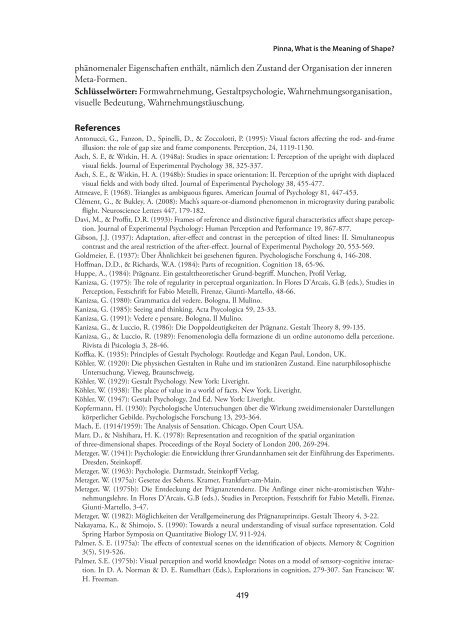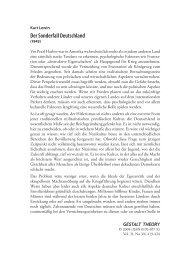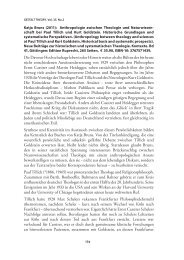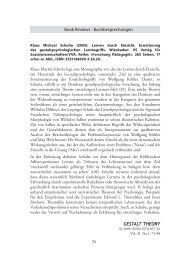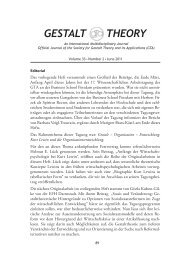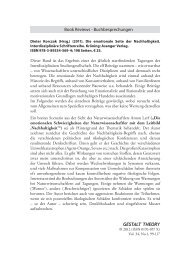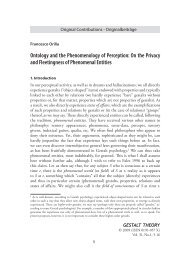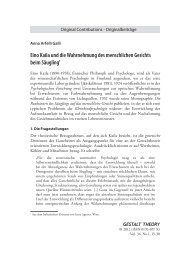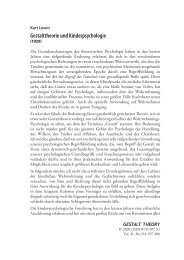What is the Meaning of Shape? - Gestalt Theory
What is the Meaning of Shape? - Gestalt Theory
What is the Meaning of Shape? - Gestalt Theory
You also want an ePaper? Increase the reach of your titles
YUMPU automatically turns print PDFs into web optimized ePapers that Google loves.
419<br />
Pinna, <strong>What</strong> <strong>is</strong> <strong>the</strong> <strong>Meaning</strong> <strong>of</strong> <strong>Shape</strong>?<br />
phänomenaler Eigenschaften enthält, nämlich den Zustand der Organ<strong>is</strong>ation der inneren<br />
Meta-Formen.<br />
Schlüsselwörter: Formwahrnehmung, <strong>Gestalt</strong>psychologie, Wahrnehmungsorgan<strong>is</strong>ation,<br />
v<strong>is</strong>uelle Bedeutung, Wahrnehmungstäuschung.<br />
References<br />
Antonucci, G., Fanzon, D., Spinelli, D., & Zoccolotti, P. (1995): V<strong>is</strong>ual factors affecting <strong>the</strong> rod- and-frame<br />
illusion: <strong>the</strong> role <strong>of</strong> gap size and frame components. Perception, 24, 1119-1130.<br />
Asch, S. E, & Witkin, H. A. (1948a): Studies in space orientation: I. Perception <strong>of</strong> <strong>the</strong> upright with d<strong>is</strong>placed<br />
v<strong>is</strong>ual fields. Journal <strong>of</strong> Experimental Psychology 38, 325-337.<br />
Asch, S. E., & Witkin, H. A. (1948b): Studies in space orientation: II. Perception <strong>of</strong> <strong>the</strong> upright with d<strong>is</strong>placed<br />
v<strong>is</strong>ual fields and with body tilted. Journal <strong>of</strong> Experimental Psychology 38, 455-477.<br />
Attneave, F. (1968). Triangles as ambiguous figures. American Journal <strong>of</strong> Psychology 81, 447-453.<br />
Clément, G., & Bukley, A. (2008): Mach’s square-or-diamond phenomenon in microgravity during parabolic<br />
flight. Neuroscience Letters 447, 179-182.<br />
Davi, M., & Pr<strong>of</strong>fit, D.R. (1993): Frames <strong>of</strong> reference and d<strong>is</strong>tinctive figural character<strong>is</strong>tics affect shape perception.<br />
Journal <strong>of</strong> Experimental Psychology: Human Perception and Performance 19, 867-877.<br />
Gibson, J.J. (1937): Adaptation, after-effect and contrast in <strong>the</strong> perception <strong>of</strong> tilted lines: II. Simultaneopus<br />
contrast and <strong>the</strong> areal restriction <strong>of</strong> <strong>the</strong> after-effect. Journal <strong>of</strong> Experimental Psychology 20, 553-569.<br />
Goldmeier, E. (1937): Über Ähnlichkeit bei gesehenen figuren. Psycholog<strong>is</strong>che Forschung 4, 146-208.<br />
H<strong>of</strong>fman, D.D., & Richards, W.A. (1984): Parts <strong>of</strong> recognition. Cognition 18, 65-96.<br />
Huppe, A., (1984): Prägnanz. Ein gestalt<strong>the</strong>oret<strong>is</strong>cher Grund-begriff. Munchen, Pr<strong>of</strong>il Verlag.<br />
Kanizsa, G. (1975): The role <strong>of</strong> regularity in perceptual organization. In Flores D’Arca<strong>is</strong>, G.B (eds.), Studies in<br />
Perception, Festschrift for Fabio Metelli, Firenze, Giunti-Martello, 48-66.<br />
Kanizsa, G. (1980): Grammatica del vedere. Bologna, Il Mulino.<br />
Kanizsa, G. (1985): Seeing and thinking. Acta Psycologica 59, 23-33.<br />
Kanizsa, G. (1991): Vedere e pensare. Bologna, Il Mulino.<br />
Kanizsa, G., & Luccio, R. (1986): Die Doppoldeutigkeiten der Prägnanz. <strong>Gestalt</strong> <strong>Theory</strong> 8, 99-135.<br />
Kanizsa, G., & Luccio, R. (1989): Fenomenologia della formazione di un ordine autonomo della percezione.<br />
Riv<strong>is</strong>ta di Psicologia 3, 28-46.<br />
K<strong>of</strong>fka, K. (1935): Principles <strong>of</strong> <strong>Gestalt</strong> Psychology. Routledge and Kegan Paul, London, UK.<br />
Köhler, W. (1920): Die phys<strong>is</strong>chen <strong>Gestalt</strong>en in Ruhe und im stationären Zustand. Eine naturphilosoph<strong>is</strong>che<br />
Untersuchung. Vieweg, Braunschweig.<br />
Köhler, W. (1929): <strong>Gestalt</strong> Psychology. New York: Liveright.<br />
Köhler, W. (1938): The place <strong>of</strong> value in a world <strong>of</strong> facts. New York, Liveright.<br />
Köhler, W. (1947): <strong>Gestalt</strong> Psychology, 2nd Ed. New York: Liveright.<br />
Kopfermann, H. (1930): Psycholog<strong>is</strong>che Untersuchungen über die Wirkung zweidimensionaler Darstellungen<br />
körperlicher Gebilde. Psycholog<strong>is</strong>che Forschung 13, 293-364.<br />
Mach, E. (1914/1959): The Analys<strong>is</strong> <strong>of</strong> Sensation. Chicago, Open Court USA.<br />
Marr, D., & N<strong>is</strong>hihara, H. K. (1978): Representation and recognition <strong>of</strong> <strong>the</strong> spatial organization<br />
<strong>of</strong> three-dimensional shapes. Proceedings <strong>of</strong> <strong>the</strong> Royal Society <strong>of</strong> London 200, 269-294.<br />
Metzger, W. (1941): Psychologie: die Entwicklung ihrer Grundannhamen seit der Einführung des Experiments.<br />
Dresden, Steinkopff.<br />
Metzger, W. (1963): Psychologie. Darmstadt, Steinkopff Verlag.<br />
Metzger, W. (1975a): Gesetze des Sehens. Kramer, Frankfurt-am-Main.<br />
Metzger, W. (1975b): Die Entdeckung der Prägnanztendenz. Die Anfänge einer nicht-atom<strong>is</strong>t<strong>is</strong>chen Wahrnehmungslehre.<br />
In Flores D’Arca<strong>is</strong>, G.B (eds.), Studies in Perception, Festschrift for Fabio Metelli, Firenze,<br />
Giunti-Martello, 3-47.<br />
Metzger, W. (1982): Möglichkeiten der Verallgemeinerung des Prägnanzprinzips. <strong>Gestalt</strong> <strong>Theory</strong> 4, 3-22.<br />
Nakayama, K., & Shimojo, S. (1990): Towards a neural understanding <strong>of</strong> v<strong>is</strong>ual surface representation. Cold<br />
Spring Harbor Symposia on Quantitative Biology LV, 911-924.<br />
Palmer, S. E. (1975a): The effects <strong>of</strong> contextual scenes on <strong>the</strong> identification <strong>of</strong> objects. Memory & Cognition<br />
3(5), 519-526.<br />
Palmer, S.E. (1975b): V<strong>is</strong>ual perception and world knowledge: Notes on a model <strong>of</strong> sensory-cognitive interaction.<br />
In D. A. Norman & D. E. Rumelhart (Eds.), Explorations in cognition, 279-307. San Franc<strong>is</strong>co: W.<br />
H. Freeman.


